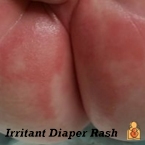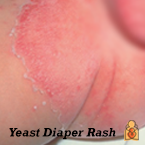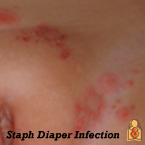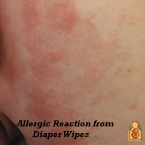By: Ingrid Polcari MD, FAAP
At least half of all babies get a diaper rash at some point. In fact, reddened, inflamed skin in the diaper area is one of the most common reasons parents seek medical care from their child's doctor.
There are many different types of diaper rashes―and they can look surprisingly similar. Use this list to help identify, soothe and prevent several different types of diaper rashes.
1. Irritant diaper rash

 The most common type of diaper rash is "irritant dermatitis." The diaper area spends much of the day in contact with two very irritating substances: urine and stool. If your child has diarrhea or is
teething―meaning extra saliva is being swallowed and passes through the gut―the chance of developing a diaper rash is even greater.
The most common type of diaper rash is "irritant dermatitis." The diaper area spends much of the day in contact with two very irritating substances: urine and stool. If your child has diarrhea or is
teething―meaning extra saliva is being swallowed and passes through the gut―the chance of developing a diaper rash is even greater.
Irritant diaper rash looks like pink or red patches on the skin covered by the diaper. The groin folds are more protected from urine and stool, so this skin usually looks normal.
Images: Examples of irritant diaper rash. The far right photo shows a more severe case with open sores.
2. Yeast infection
 Another fairly common cause of diaper rash is yeast infection, caused by overgrowth of a type of fungus found naturally in the digestive tract. Clues that the rash might be due to a yeast infection include shiny, bright red or pink patches with sharp edges. This rash may also have little pink bumps or pimples. In severe cases, there may be sores or cracking skin that oozes or bleeds. Unlike with irritant diaper rash, a yeast diaper rash is usually worse in the groin folds.
Another fairly common cause of diaper rash is yeast infection, caused by overgrowth of a type of fungus found naturally in the digestive tract. Clues that the rash might be due to a yeast infection include shiny, bright red or pink patches with sharp edges. This rash may also have little pink bumps or pimples. In severe cases, there may be sores or cracking skin that oozes or bleeds. Unlike with irritant diaper rash, a yeast diaper rash is usually worse in the groin folds.
A yeast diaper rash may develop after your baby has taken antibiotics. If your baby has this type of diaper rash, be sure to wash your hands thoroughly before and after diaper changes. Your pediatrician may recommend or prescribe a topical antifungal cream for the rash.
See Thrush and Other Candida Infections.
Image:
Scaling skin spreading to the thighs and abdomen is
typical
with a yeast (candida) diaper rash.
3. Bacteria

 Rarely, diaper rash can be caused by a bacterial infection. This is also called
impetigo. Certain types of bacteria (like
staph and
strep) can cause diaper rash or make an existing one worse. Bright red skin around the anus can be a clue to a strep infection. Yellow crusting, weeping, or pimples can be a clue to a staphylococcus or "staph" infection. Any infection in the diaper area needs to be confirmed and treated by your child's doctor.
Rarely, diaper rash can be caused by a bacterial infection. This is also called
impetigo. Certain types of bacteria (like
staph and
strep) can cause diaper rash or make an existing one worse. Bright red skin around the anus can be a clue to a strep infection. Yellow crusting, weeping, or pimples can be a clue to a staphylococcus or "staph" infection. Any infection in the diaper area needs to be confirmed and treated by your child's doctor.
Images: Left, strep infection diaper rash; Right: staph diaper infection
Do not use over-the-counter antibiotic ointment for diaper rashes; sometimes ingredients in these products can worsen skin irritation.
4. Allergy
 Occasionally, babies with sensitive skin may have an
allergic reaction to a specific ingredient in diapers, wipes and/or creams. Common allergens include dyes or elastics in the diaper, and fragrances or preservatives in diaper wipes or creams. Clues that might suggest an allergy include a rash that happens after every exposure to that product and a rash that shows up everywhere that product is applied. Switching brands or types of products for a 2-week period can sometimes help sort this out.
Occasionally, babies with sensitive skin may have an
allergic reaction to a specific ingredient in diapers, wipes and/or creams. Common allergens include dyes or elastics in the diaper, and fragrances or preservatives in diaper wipes or creams. Clues that might suggest an allergy include a rash that happens after every exposure to that product and a rash that shows up everywhere that product is applied. Switching brands or types of products for a 2-week period can sometimes help sort this out.
Image: allergic reaction to diaper wipes.
5. Other rare types of diaper rashes
There are rare conditions that can start as or mimic diaper rash. Examples include seborrheic dermatitis, which may involve overproduction of oil in the skin, and pediatric
psoriasis. Genetic conditions such as acrodermatitis enteropathica, an inherited form of zinc deficiency, may also cause rashes in the diaper area.
The bottom line on diaper rash
Talk with your pediatrician if you have any questions about diaper rashes, and how to treat and prevent them.
More information
About Dr. Polcari:
 Ingrid Polcari MD, FAAP, is an Associate Professor in the Departments of Dermatology and Pediatrics at the University of Minnesota. Within the American Academy of Pediatrics, she is a member of the Section on Dermatology. She is also a member of the Education Committee within the Society for Pediatric Dermatology. Ingrid Polcari MD, FAAP, is an Associate Professor in the Departments of Dermatology and Pediatrics at the University of Minnesota. Within the American Academy of Pediatrics, she is a member of the Section on Dermatology. She is also a member of the Education Committee within the Society for Pediatric Dermatology.
|